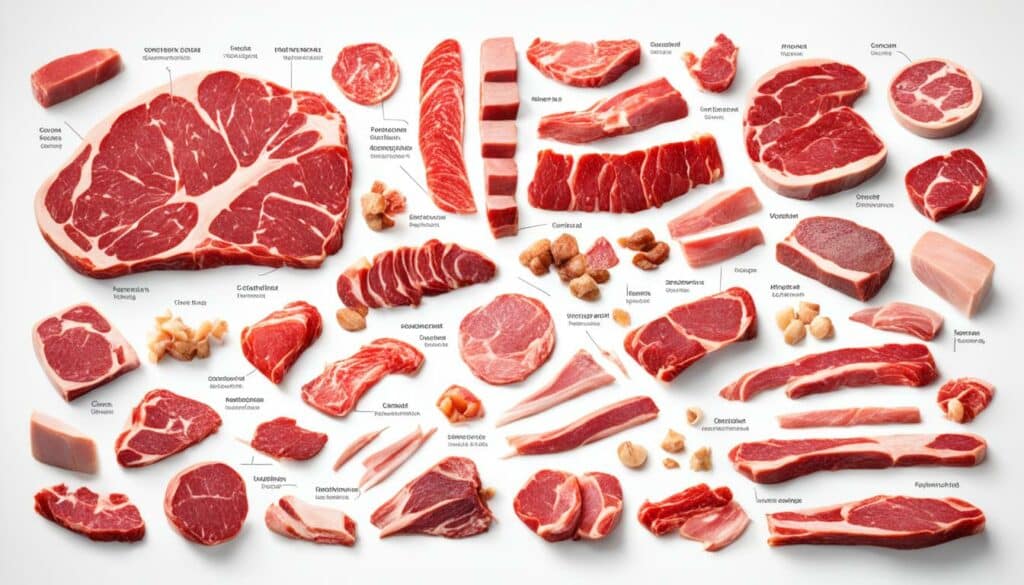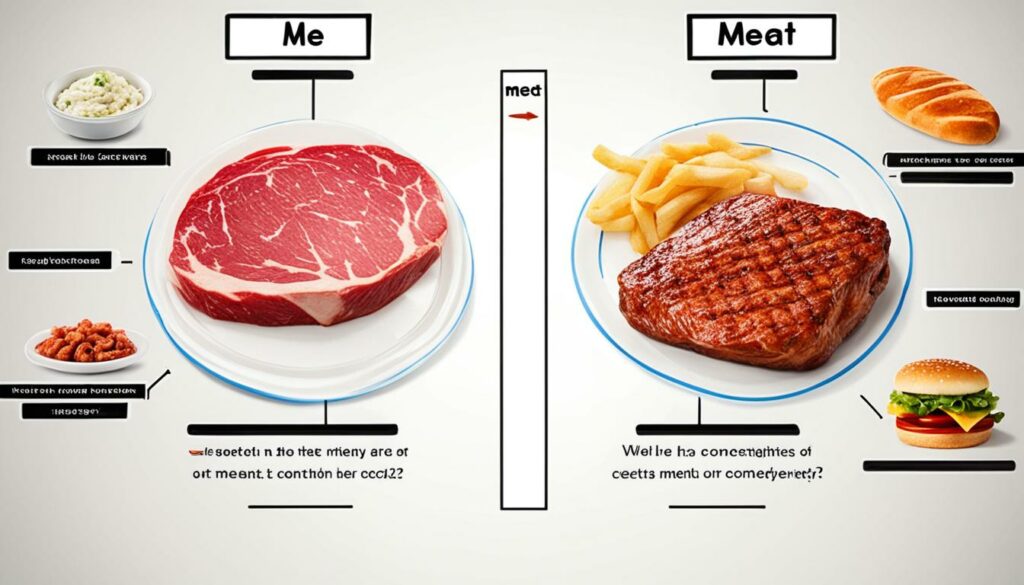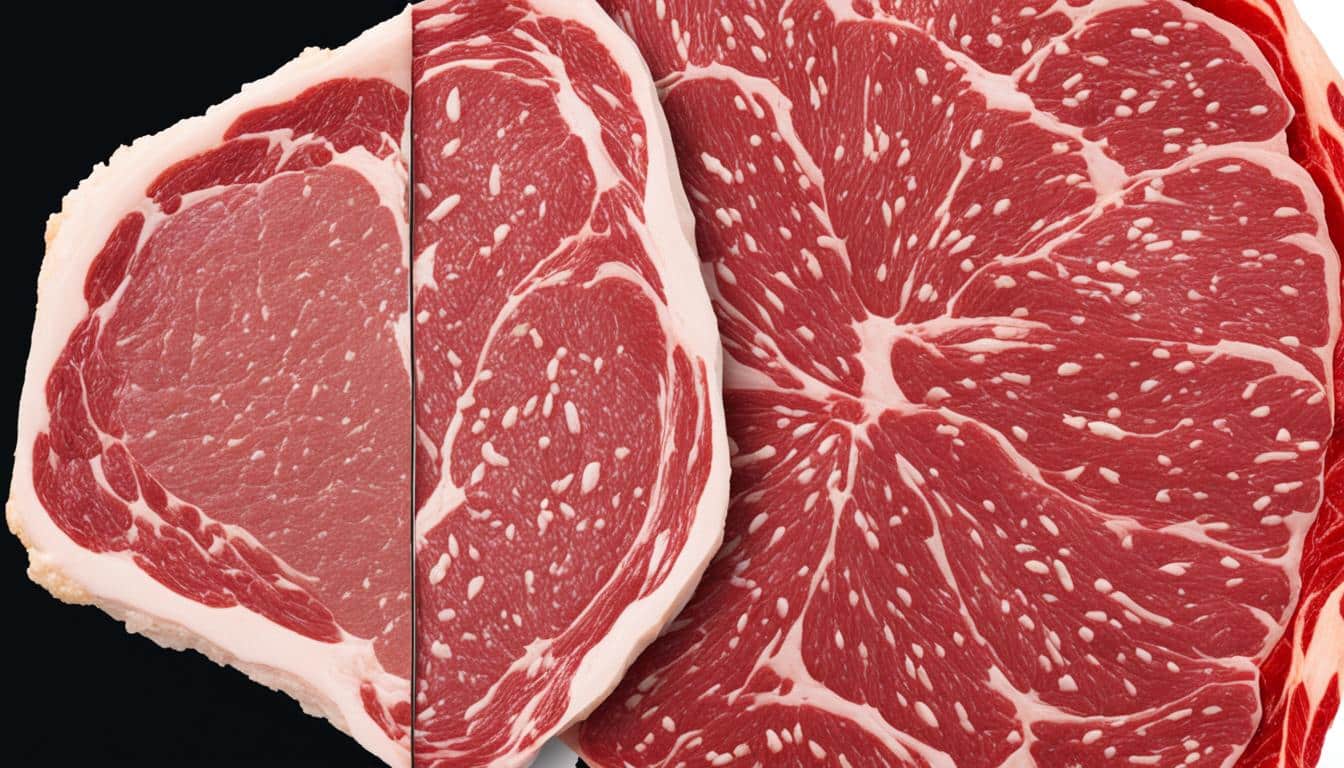The words meet and meat may sound the same, but they have distinct meanings. It’s important to understand the difference between these two commonly confused words to ensure clear communication. Let’s explore the nuances of meet and meat and how to use them correctly.
Key Takeaways:
- Meet is a verb that refers to making personal contact or coming together, while meat refers to food for animals or humans.
- Remember that meat contains the word “eat,” which helps distinguish it from meet.
- Meet can be used as a verb or a noun, referring to social interactions or gatherings.
- Meat is strictly a noun, referring to the flesh of an animal or the crucial part of something.
- Pay attention to the context of your sentence to determine whether to use meet or meat.
Meet Definition
When it comes to defining meet, it serves as both a verb and a noun. As a verb, it refers to the act of coming together or making personal contact. This can involve people meeting for the first time or objects converging at a specific point, such as where roads meet. On the other hand, meet can also function as a noun, denoting a gathering or event, particularly in the context of certain sporting activities like track and field or gymnastics. Some synonyms for meet include match, manage, and get together.
Examples:
“Let’s meet at the park this afternoon to discuss our plans for the weekend.”
“The two roads meet at a busy intersection in the city center.”
Usage:
As a verb:
- I’ll meet you at the cafe at 7 PM.
- She met her future business partner at a networking event.
As a noun:
- The track and field meet will take place next week.
- He attended a business meet to network with potential clients.
| Part of Speech | Definition | Examples |
|---|---|---|
| Verb | To come together or make personal contact | “Let’s meet for lunch tomorrow.” |
| Noun | A gathering or event | “Are you attending the company’s annual meet?” |
Understanding the various nuances of the word meet allows for more precise and effective communication. Whether you’re arranging a social gathering or referring to a specific event, using meet appropriately ensures clarity in your interactions.
Meat Definition
In order to fully understand the difference between meet and meat, it’s important to delve into the meaning of meat. Meat is a noun that refers to the flesh of an animal that is consumed by humans or animals alike.
When we think of meat, we often envision some of the most common examples like beef, chicken, pork, and venison. These are all types of meat that are commonly found on dinner plates around the world.
However, the term also extends beyond its culinary connotation. It can also be used to describe the most important part of something, much like the kernel, core, or heart of a matter.
By understanding the diverse applications of this word, we can better comprehend its meat definition and how it is used in different contexts.

The Synonyms of Meat
Let’s explore some synonyms of meat to gain a deeper perspective:
- Kernel: This word refers to the core or essential part of something.
- Core: Similar to kernel, core denotes the central and most important aspect of an object or idea.
- Heart: Used metaphorically, heart represents the vital and central component of a concept or endeavor.
These synonyms highlight the significance and centrality associated with the concept of meat.
Meat Definition in Context
“The meat of the argument lies in the final few paragraphs, where the author presents their most compelling evidence.”
In this context, meat alludes to the essential and substantial points that form the crux of an argument in an essay or any written piece.
Now that we’ve established the meaning of meat and explored its various applications, let’s move on to understanding the difference between meet and meat in the next section.
| Term | Definition |
|---|---|
| Meat | The flesh of an animal consumed as food |
Understanding the Difference
Meet and meat are homophones, meaning they sound the same but have different meanings and spellings. The confusion between these words often arises due to their similar pronunciation, but it is important to understand their distinct meanings for clear communication.
Meet is related to social interactions or coming together. It can be used as a verb or a noun. As a verb, it means to make personal contact or come together. It can refer to people getting together, especially for the first time, or objects coming together, such as where roads meet. As a noun, meet refers to a gathering, particularly in the context of certain sporting events like track and field or gymnastics.
Meat is associated with food, particularly animal flesh. It is a noun that refers to the flesh of an animal that is consumed by humans or animals. Examples of meat include beef, chicken, pork, and venison. It can also refer to the most important part of something, such as the main points of an essay.
To avoid confusion between meet and meat, remember that meet is about social interactions or coming together, while meat is about food, specifically animal flesh. By understanding the difference, you can use these words correctly and communicate more effectively.
Example:
“Let’s meet at the restaurant for dinner tonight. I heard they serve delicious meat dishes!”
Key Points:
- Meet and meat are homophones with different meanings.
- Meet refers to social interactions or coming together.
- Meat relates to food, specifically animal flesh.
- Understanding the difference between meet and meat is essential for clear communication.
Examples and Usage
To further illustrate the difference between meet and meat, consider these examples:
- “I bought some fresh meat from the butcher for tonight’s dinner.”
(referring to animal flesh used as food)
- “Let’s meet at the café tomorrow morning to discuss the project.”
(referring to scheduling a gathering or coming together)
Using these words correctly in context is crucial for effective communication.

Tips and Tricks
Remembering the difference between meet and meat can be a challenge, but these tips can help you avoid confusion and use the right word in the right context.
- Associate meat with food: When you think of meat, think of it as something you eat. This association can help you remember that meat refers to animal flesh used for consumption.
- Associate meet with social interactions: Meet sounds like “meeting,” which is all about coming together and interacting with others. Use meet when referring to people gathering or coming together for an event.
- Consider the context: If you’re still unsure which word to use, think about the context of your sentence. If it involves food or cooking, use meat. If it involves social interactions or gatherings, use meet.
- Pay attention to word usage: The more you expose yourself to the correct usage of meet and meat, the easier it will be to remember the difference. Engage in reading, writing, and conversation to improve your vocabulary.
By following these tips and being mindful of the context, you can avoid the confusion between meet and meat, enhance your language skills, and communicate clearly and accurately.
Example:
“Let’s meet at the park for a picnic. I’ll bring the meat for the barbecue.”
Conclusion
Understanding the distinction between meet and meat is crucial for precise and clear language usage. While these words may sound alike, they have different meanings and applications. Meet, as a verb, relates to social interactions, gatherings, or coming together. On the other hand, meat is a noun referring to food, particularly animal flesh.
By keeping these differences in mind, you can effectively use meet and meat in your writing, preventing any confusion or ambiguity. Remember, meat contains the word “eat,” which can serve as a helpful mnemonic to associate it with food. Additionally, paying attention to the context of your sentence can guide you in choosing the correct word.
Being aware of the distinctions between meet and meat enhances your vocabulary and helps you communicate more accurately. Whether you are scheduling a meeting or discussing a delicious steak, using these words correctly ensures your message is conveyed with clarity and precision.
FAQ
What is the difference between meet and meat?
Meet is a verb that means to make personal contact or come together, while meat refers to food for animals or humans.
How can I define meet?
Meet can be a verb or a noun. As a verb, it means to come together or make personal contact. As a noun, it refers to a gathering, particularly in the context of certain sporting events.
How can I define meat?
Meat is a noun that refers to the flesh of an animal that is consumed by humans or animals. It can also refer to the most important part of something.
Why are meet and meat often confused?
Meet and meat are homophones, meaning they sound the same but have different meanings and spellings. The confusion often arises due to their similar pronunciation.
Can you provide examples of using meet and meat?
Certainly! For example, “I bought some fresh meat from the butcher for tonight’s dinner” (referring to animal flesh used as food) and “Let’s meet at the café tomorrow morning to discuss the project” (referring to scheduling a gathering or coming together).
How can I remember the difference between meet and meat?
It can be helpful to associate meat with food and meet with social interactions. If your sentence involves food, use meat; if it involves social interactions or coming together, use meet.










